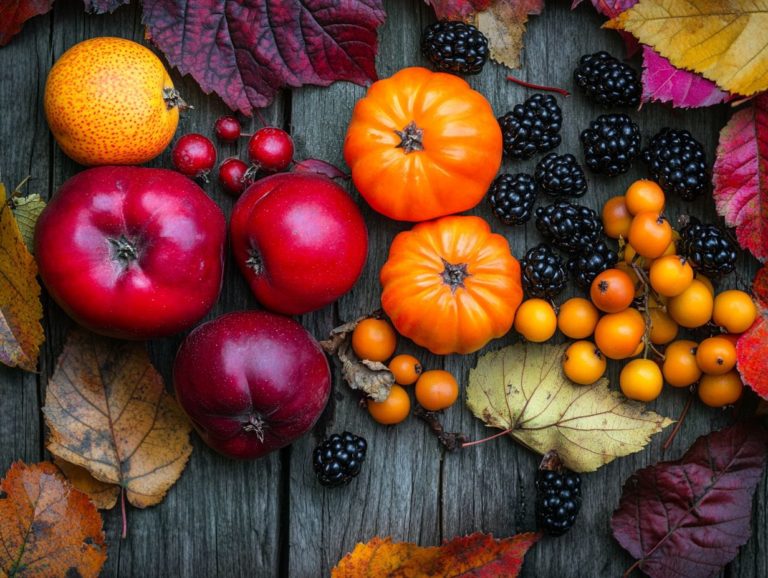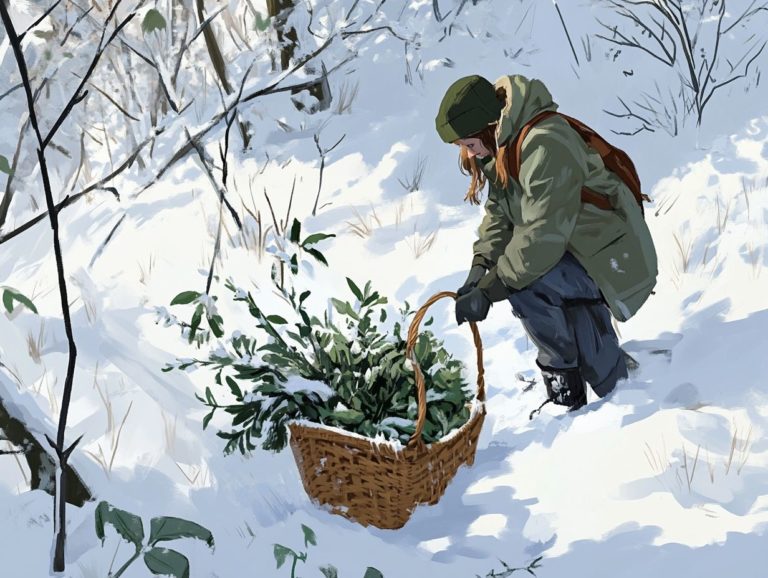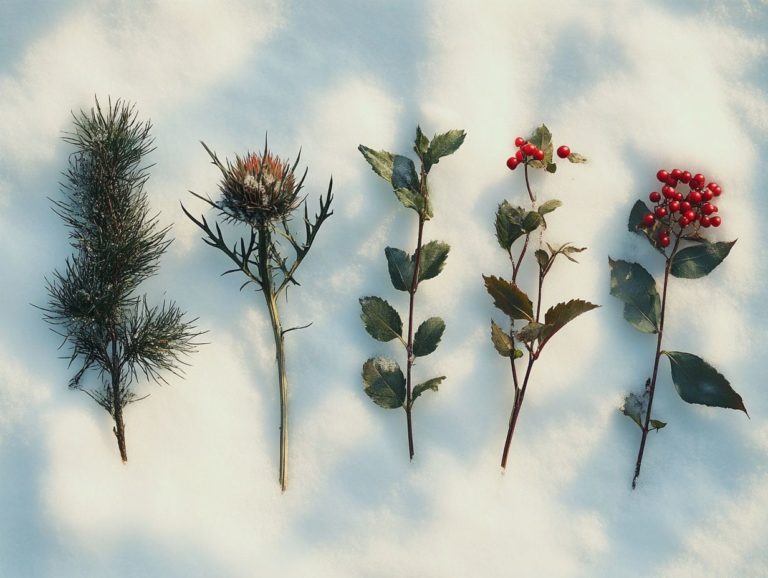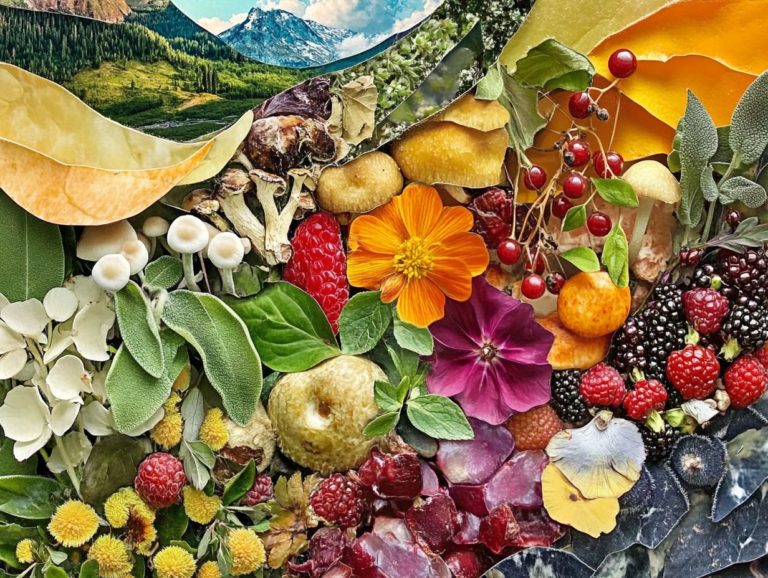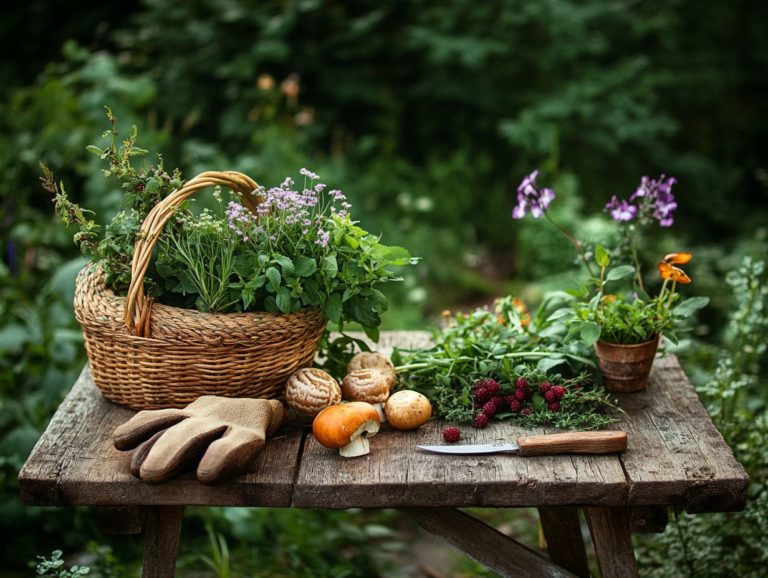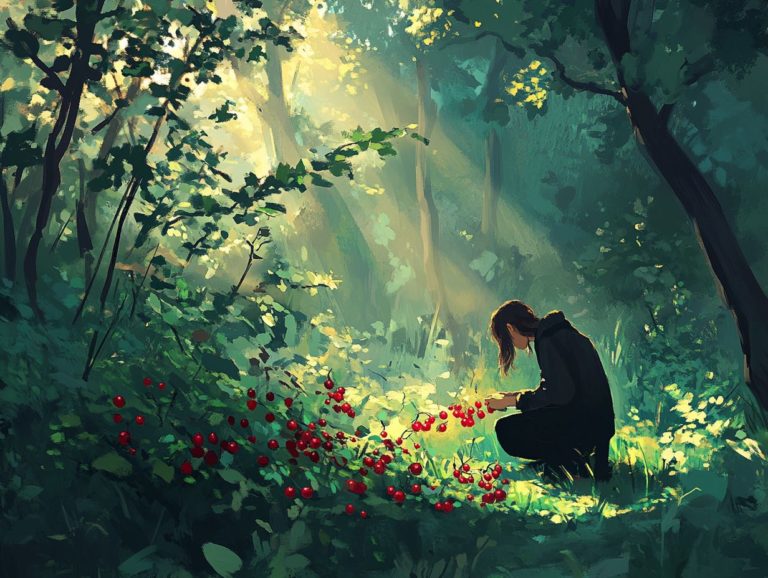Foraging Calendar: What to Gather Each Month
Foraging transcends mere trendiness; it offers a unique opportunity for you to connect deeply with nature and uncover the abundant treasures that surround you. Get ready to dive into the great outdoors and transform your cooking adventures into something extraordinary!
This comprehensive guide delves into the myriad benefits of foraging, ranging from nutritional enhancements to environmental advantages. You ll find a carefully curated month-by-month foraging calendar so you ll always know what s in season and ripe for the picking.
Essential safety tips and a detailed overview of common edible plants and fungi are included to ensure your foraging experience is enjoyable and secure. Don t wait start exploring your local environment for wild edibles today!
Contents
- Key Takeaways:
- Benefits of Foraging
- Foraging Calendar
- Foraging Safety
- Common Edible Plants and Fungi
- Frequently Asked Questions
- What is a foraging calendar and why is it important?
- What are some benefits of using a foraging calendar?
- What can I expect to gather in January according to the foraging calendar and seasonal change?
- Is it safe to eat foraged foods from the wild?
- Can I forage for food in urban areas?
- What should I bring with me when foraging?
Key Takeaways:
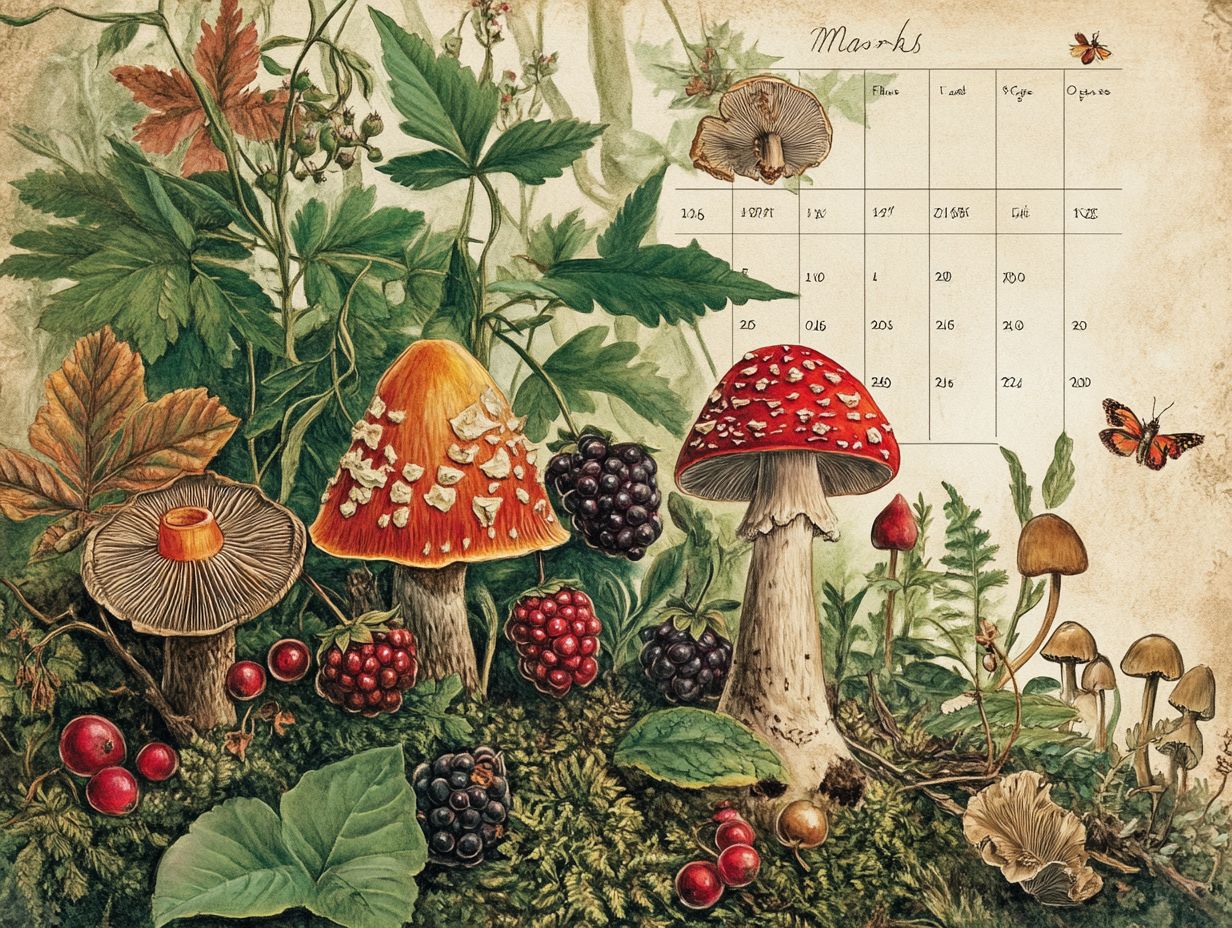
- Foraging is the practice of gathering wild food for personal use, with numerous nutritional and environmental benefits.
- A month-by-month foraging calendar can guide foragers on what to gather, based on seasonal availability and sustainability.
- Prioritize safety and responsibility when foraging by researching, correctly identifying, and properly preparing edible plants and fungi.
What is Foraging?
Foraging, or searching for wild food, is a practice that connects us to nature. It involves seeking out and gathering wild foods that nature generously provides, especially in Britain, where the rhythm of the seasons dictates which ingredients are ripe for the picking. For a deeper understanding, check out our guide to seasonal foraging in your area.
Engaging in this timeless practice allows you to connect deeply with the natural world and elevates your home cooking by infusing fresh, wild elements into your daily meals.
Historically, foraging has been essential for survival, giving communities the power to flourish by making the most of their surroundings. In today’s world, you ll find various forms of foraging like urban foraging and forest foraging each reflecting the unique environments and diverse flora they encompass.
Seasonal changes influence the wild foods available, guiding you from the tender greens of spring to the hearty mushrooms of autumn. Exploring foraging in urban environments fosters a close relationship with the landscape, nurturing a profound appreciation for balance in nature and promoting sustainable food practices.
By weaving wild ingredients into your culinary creations, you enhance the flavors of your dishes and reconnect with the earth’s abundant gifts. This ensures that the rich tradition of food foraging continues to enrich our culinary heritage.
Benefits of Foraging
The benefits of foraging go well beyond just gathering food; it provides you with a unique opportunity to connect deeply with nature. Engaging in foraging promotes sustainable practices, allowing you to appreciate the ecosystem while enjoying the bounty it offers.
The wild edible plants you discover are often richer in nutrients than cultivated ones, making your foraging adventures not only rewarding but also beneficial for your well-being.
Nutritional and Environmental Advantages
Foraging allows you to harness the nutritional benefits of wild ingredients, which often boast higher concentrations of vitamins and minerals compared to their cultivated counterparts. This practice champions environmental sustainability, promoting biodiversity and reducing dependence on commercial food sources.
Consider foraged foods like wild greens and mushrooms; they often come packed with antioxidants and essential fatty acids that enhance your overall health and well-being. Engaging in foraging fosters a profound connection with nature and cultivates an appreciation for local ecosystems. This highlights the crucial need to preserve wildlife habitats.
By weaving wild foods into your diet, you savor diverse flavors and exciting culinary experiences. You also actively engage in ecological conservation efforts. This harmonious relationship enriches your personal nutrition while contributing to the protection of our planet’s invaluable resources.
Foraging Calendar
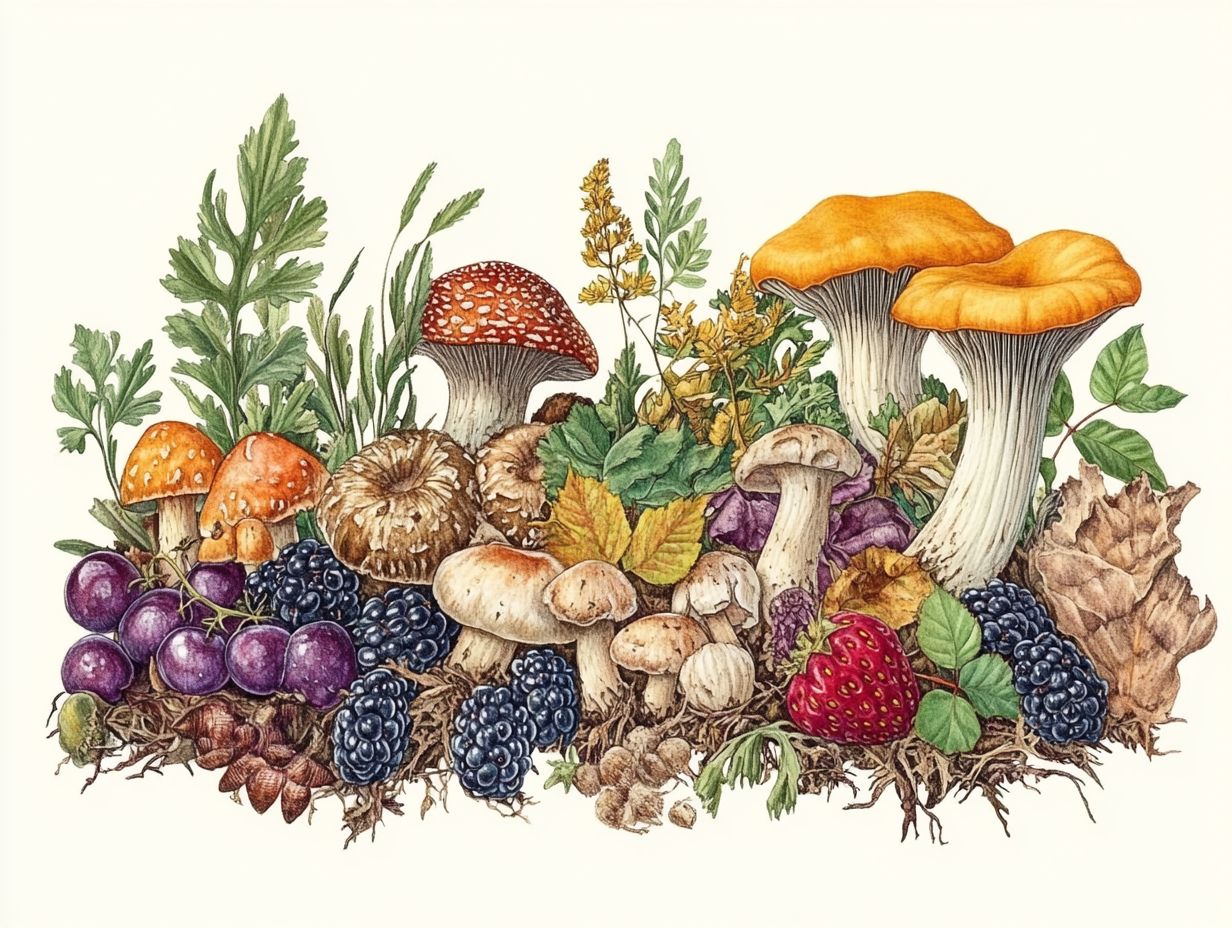
A foraging calendar is an essential tool for enthusiasts, outlining what to look for during different seasons and providing a seasonal foraging checklist of wild ingredients throughout the year.
Picture vibrant spring greens and aromatic wild garlic. They transition to a rich tapestry of berries and mushrooms in autumn.
This calendar gives you the power to plan your foraging adventures and craft delightful recipes with ease and confidence, using insights from a seasonal guide on foraging techniques.
Month-by-Month Guide for Foraging
The month-by-month guide for foraging helps you identify and gather a diverse array of wild ingredients throughout the year, including seasonal foraging tips for vibrant spring greens and wild garlic.
Then transition to the luscious blackberries and elderberries of summer. All these ingredients make it easier for you to whip up seasonal recipes that truly celebrate nature’s bounty.
As autumn arrives, you can revel in the rich flavors of chestnuts and acorns. They add a delightful depth to your savory dishes and baked goods.
When winter rolls in, the adventurous spirit in you will find joy in searching for hardy winter greens and the unique taste of wild mushrooms. Your culinary journey continues even in the colder months.
By participating in foraging classes, you can deepen your understanding of plant identification. You’ll learn skills that nourish not just your body but also your spirit.
These educational opportunities offer invaluable insights into the culinary uses of local flora. They transform gathering and preparing food into a true celebration of the earth s rich offerings.
Foraging Safety
Foraging safely is essential for a rewarding and enjoyable experience. By following established foraging guidelines and learning how to identify plants, you can avoid toxic plants.
Additionally, gaining a thorough understanding of local ecosystems contributes to sustainable practices. This thoughtful approach enhances your foraging adventures.
Tips for Safe and Responsible Foraging
To ensure safe and responsible foraging, adhere to key principles. These include consulting reliable foraging guidelines, practicing diligent plant identification, and being conscious of your impact on local ecosystems.
Attending local foraging courses can be immensely beneficial. Here, experts share their knowledge and practical experiences.
This sharpens your skills in identifying edible plants and deepens your understanding of the local environment.
It’s crucial to familiarize yourself with local regulations about foraging. This knowledge is essential for sustainable practices.
By adopting responsible gathering methods such as only harvesting what you need and leaving enough for wildlife you contribute to preserving the variety of life in a particular ecosystem.
With a mindful approach to foraging, you can relish the experience while safeguarding nature’s bounty for future generations.
Common Edible Plants and Fungi
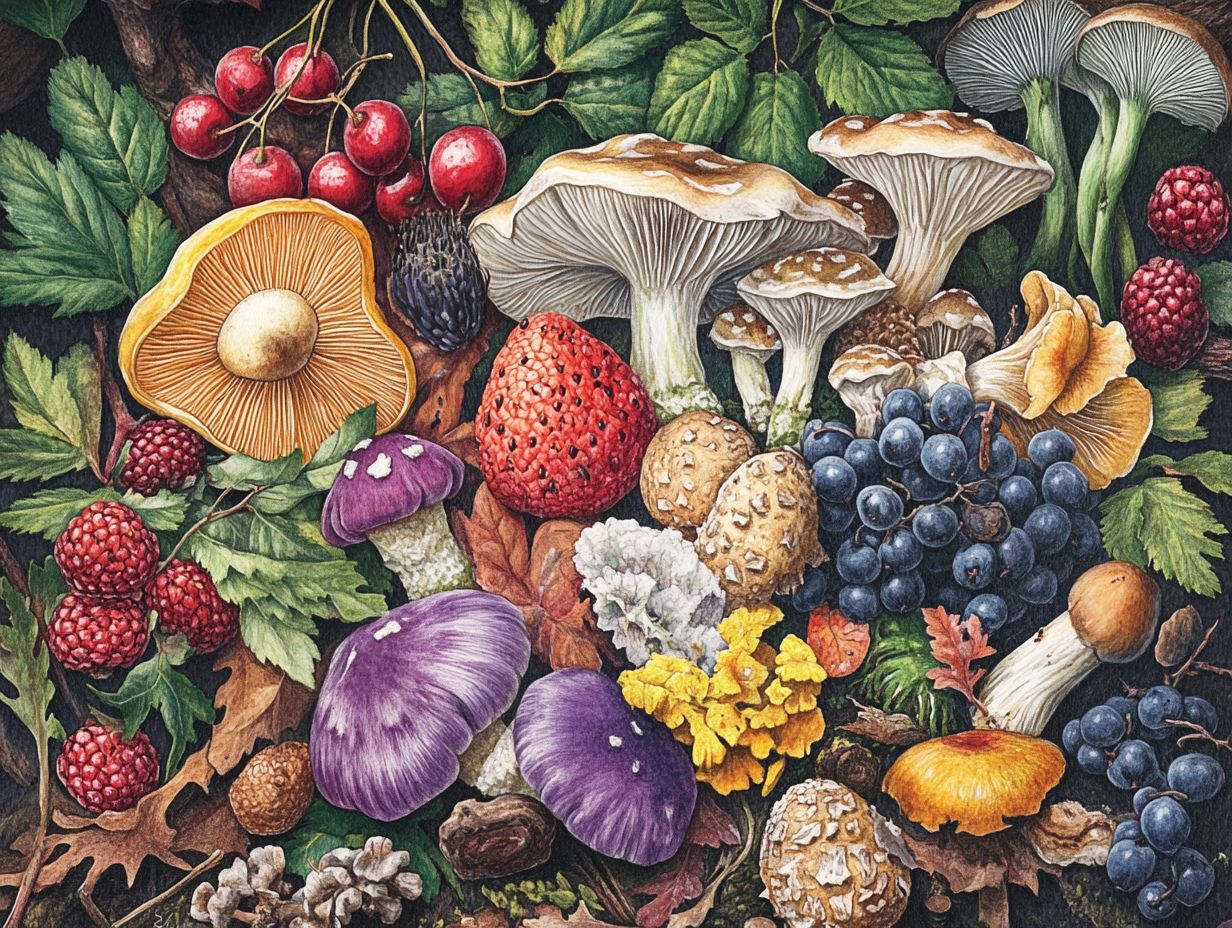
Common edible plants and fungi offer a treasure trove of nutrition and flavor for the discerning forager. For instance, you can learn about seasonal foraging techniques and imagine discovering wild garlic and chickweed in the vibrant spring.
Then transition to delightful blackberries and a variety of mushrooms in crisp autumn. These elements are not just mere ingredients; they are essential components of the foraging journey.
They enrich your connection to nature and enhance your culinary experiences.
Identification and Preparation
Effective identification and preparation of wild ingredients are essential for your foraging adventure. They allow you to safely enjoy nature’s bounty while creatively integrating these treasures into your culinary repertoire.
Understanding the characteristics of each plant and fungi is crucial. Look for specific markers like leaf patterns, flower colors, and the tiny dust-like particles released by mushrooms. Using field guides and mobile apps can help you distinguish edible varieties from harmful ones. For example, when foraging for mushrooms, pay close attention to the gills, cap shape, and habitat.
Preparation methods can vary widely, but mastering basic cooking techniques, such as saut ing wild greens or brewing herbal teas, will elevate the flavors. Imagine whipping up saut ed fiddlehead ferns with garlic or a vibrant wild garlic pesto; these delightful dishes celebrate the uniqueness of your wild finds.
Frequently Asked Questions
What is a foraging calendar and why is it important?
A foraging calendar outlines which wild plants, fruits, and other natural resources are available to gather each month. Don’t miss out! Following a seasonal guide foraging through the year ensures you catch nature’s best offerings.
What are some benefits of using a foraging calendar?
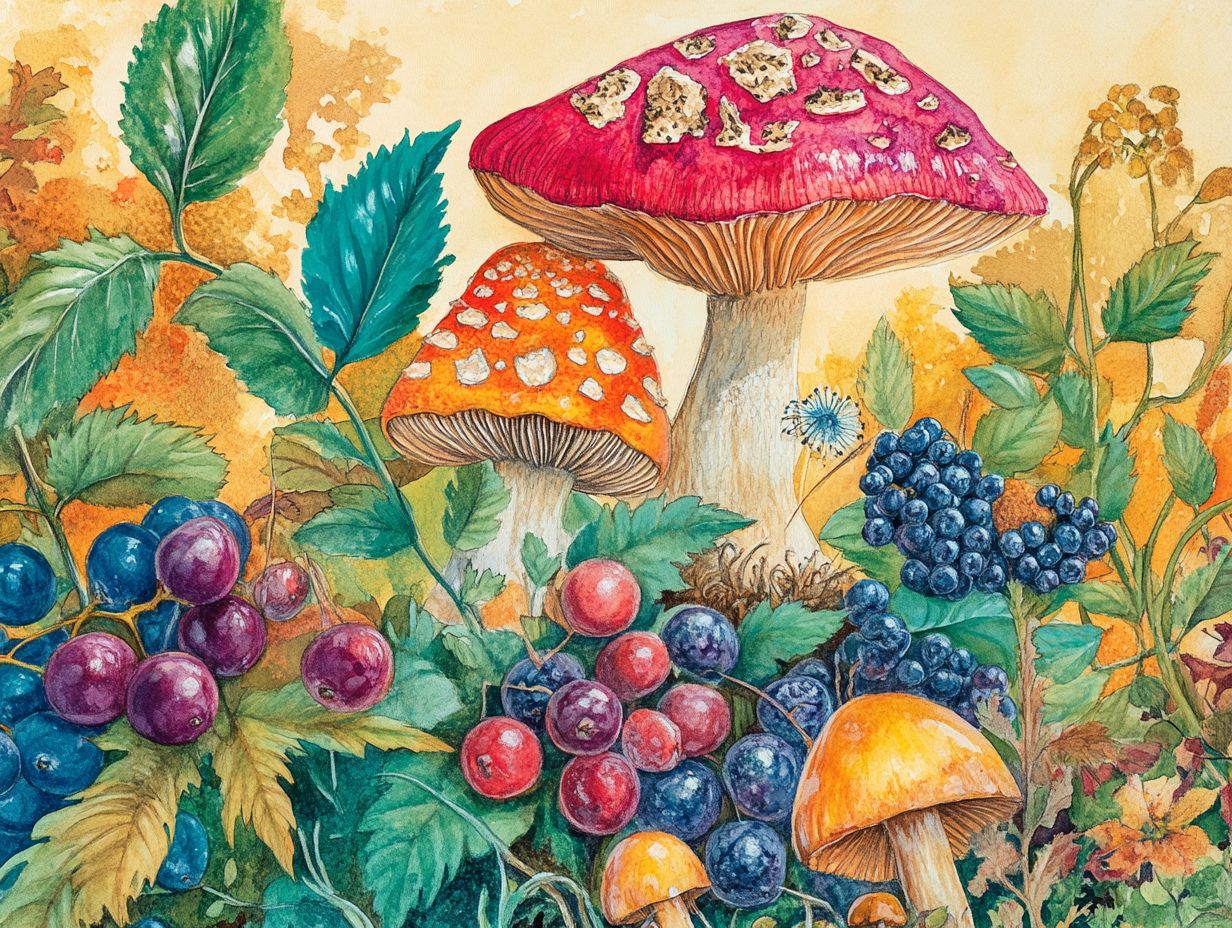
Using a foraging calendar lets you take advantage of the natural bounty of each month, ensuring you gather the most abundant and nutritious resources. This knowledge helps prevent disappointment by letting you know the best times to gather edibles and when they are available, while also helping you avoid accidentally harvesting protected or endangered species.
What can I expect to gather in January according to the foraging calendar and seasonal change?
In January, expect to gather cold-hardy greens like winter cress and wild mustard, as well as winter fruits such as rose hips, persimmons, and hawthorn berries. This is also a great time to collect nuts that ripened in the fall but are still available on the ground. For those interested in foraging, seasonal edibles can provide a wealth of options as spring approaches.
Is it safe to eat foraged foods from the wild?
You can safely enjoy foraged foods if you identify them correctly and follow safe harvesting practices. It s vital to be cautious and consult a reputable foraging guide if you are unsure about a particular plant or berry.
Can I forage for food in urban areas?
Yes, you can discover wild edibles even in urban areas! Look for parks, abandoned lots, and green spaces where wild plants and fruits may grow. Always obtain permission before foraging on private property and avoid areas that may have been contaminated.
What should I bring with me when foraging?
When foraging, bring the following items:
- A foraging guide or reference materials
- A bag or basket to collect your items
- Gloves
- A knife
- Water and snacks for longer trips
Make sure to wear appropriate clothing and footwear for the weather and terrain. Enjoy your foraging adventure!
Ready to start your foraging journey? Explore the wild and discover the treasures nature has to offer!

